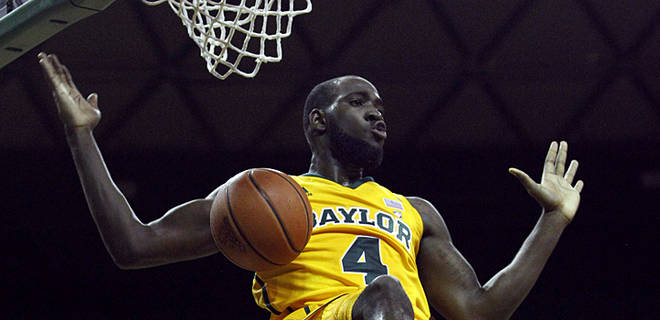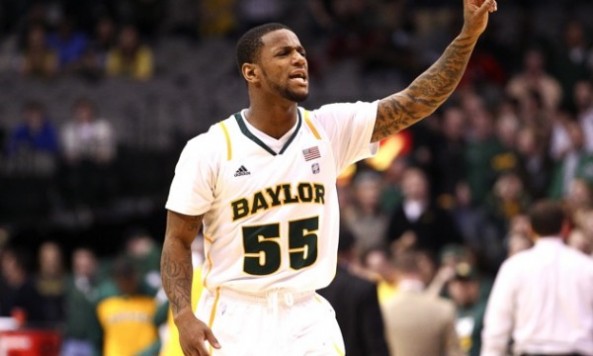On Tuesday night, Baylor picked up arguably the best road win of the college basketball season, a two-point triumph over
So while the Bears already had road wins over tournament hopefuls Northwestern and BYU (which is more than most top teams can lay claim to away from home), Tuesday’s win has Baylor being evaluated in a different light. Consequently, it makes sense to see what we can learn from looking at the tempo-free stats the Bears have compiled through 16 games.
Interestingly enough, for a team known for their tremendous athleticism and talent on offense, they actually rank higher in adjusted defensive efficiency. Of the four factors, the only one where they rank outside the Top 40 is in opponents’ OReb%, which is surprising given their own ability to snatch offensive boards.

The Bears rank 10th in block percentage at 16.1% thanks to a long and athletic frontcourt who can erase anything near the basket. Quincy Acy is the first shot-blocker you would name on Baylor’s roster, and his 8.5 block percentage backs that up. But sophomore Cory Jefferson, who gained a lot of confidence on the team’s exhibition tour this summer, actually has a 13.5 block percentage. Thanks in part of their shot-blocking prowess, the Bears have allowed opponents to make just 39.7 percent of their two-pointers, good for eighth nationally.
Baylor has also really improved their defensive turnover rate, which is up to 24.3. Not coincidentally, they are in the Top 20 in steal percentage, led by A.J. Walton (4.8%), Pierre Jackson (3.8%), and Anthony Jones (3.4%). Knowing they have such long and talented players behind them to challenge and/or block shots certainly allows them to gamble for steals a bit more. At the same time, they’ve also reduced their opponents’ free throw rate to just 29.2.
Overall, they have allowed just three opponents to score more than 0.94 points per possession. Admittedly, some of their defensive numbers are slightly skewed based on who they have played, but I would also argue Baylor has knocked off seven teams that would either be in the field of 68 or at least on the bubble.
On offense, the Bears rank 23rd with a 54.2 eFG%. It would be easy to give all the credit for that to a deep and talented collection of forwards, and to their credit, the team is hitting 51.6 percent of their twos. However, the team is actually 21st in three-point shooting, thanks in large part to
The team also ranks in the Top 50 in OReb%, although no one player stands out. It’s truly a team effort on the offensive glass with five players posting an OReb% of at least 9.1. Not surprisingly, Quincy Acy is among the team leaders there, but he’s also leading the Bears in FT Rate at 76.6. As a team, the team owns a strong 41.2 FTR, which has carried over from the team’s success in that area last season. In total, six players have a FTR of at least 48.4.
As a team, Baylor has scored at least 1.03 ppp in all but three games, and they have scored 1.10 ppp or more on 11 occasions. That’s even more impressive in light of their poor turnover rate, which is the team’s one glaring weakness.
Baylor’s 22.2 TO% ranks 248th in the nation, but it’s an improvement over last season’s 23.4 mark, which was among the 25 worst teams in the country. Based on that poor performance, there were serious questions at the point guard spot coming into this season with A.J. Walton the lone returnee at the position.
Walton posted a solid 27.3 assist rate last season, but he offset that with a 32.1 TO% and struggles shooting the ball. Many people (myself included) were skeptical that Walton would be able to run the show for a team with Top 10 level talent.
Enter Pierre Jackson, a juco All-American with an electric game and impressive hops for someone standing just 5-foot-10. The reality is that his 30.4 TO% isn’t substantially better than Walton’s, which has risen slightly to 33.6. However, the gap between their shooting percentages is vast.
The good news is that both guys have assist rates over 30, with
In addition,
It’s surprising to think I’ve made it this far without even mentioning Perry Jones III or Quincy Miller. Jones surprised many by heading back to
Miller, a highly rated incoming freshman, played well in Jones’ absence early on. His overall 105.4 ORtg is solid, and his rebounding percentages are relatively similar to what Jones has posted. Miller also has a nice assist rate compared to other forwards, and he’s drawn 5.3 fouls per 40 minutes. He also gives the Bears another able shot-blocker, and the biggest knock on him is a 21.1 TO%.
As talented as those guys are, the MVP of this team is Quincy Acy. The senior forward has made his reputation on thunderous dunks, but he’s quietly become one of the most efficient and important players in college hoops. He makes 58.3 percent of his twos and has shown he can consistently make shots other than dunks. As mentioned above, he’s a high level offensive rebounder and boasts high numbers in block percentage and FTR. Acy also does a terrific job on the defensive glass and manages to have a tremendous impact on the game despite having a usage rate and shot percentage under 20.
It would seem the win at
Follow me on Twitter (@AndyBottoms) for more of my thoughts on college basketball.























